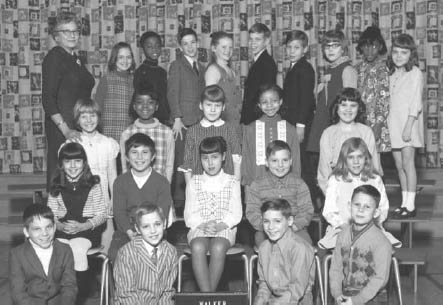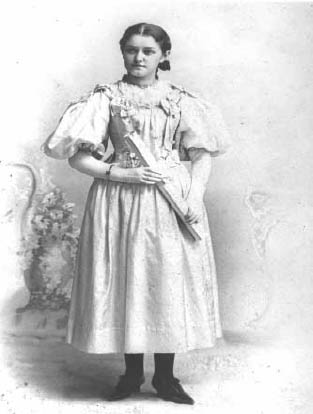Remembering Conshohocken and West Conshohocken (13 page)
Read Remembering Conshohocken and West Conshohocken Online
Authors: Jack Coll

A year later, the school board purchased land on Forrest Street below Hector Street and built a schoolhouse. This building later was purchased by Davey Stemple and became known as Stemple's Hall, where the Washington Fire Company was later organized. While at the school on Forrest Street, Mr. Schuick served as principal.

The 1969 class photograph of third-grade students from Hervey S. Walker Elementary School included
front row, left to right
: Nicholas Malantonio, Steven Bolger, Thomas Kennedy and Dennis Kelly.
Second row, left to right
: Marcia Intrieri, John Boccella, Joanne Suchecki, Michael Markoski and Chris Ingram.
Third row, left to right
: Donna Donovan, Pattie House, Frances Balkiewicz, Debbie Banks and Bridget Piatelli.
Back row, left to right
: Dorothy Murray, Debbie White, Darryl Lee, Matthew Wertz, Julie Ball, Michael Orler, Daniel Yucalevich, Susan Lontkowski, Renee Dean and Mary Wambold.
Within five years, the school board had used three different locations for the school building, and once again the schoolhouse became too small to accommodate the growing number of students. In 1855, the school board purchased another lot of ground from Theodore Trewendt for $900 to build a more suitable schoolhouse. The property was located high on a hill overlooking the turnpike (now the 100 block of Fayette Street), backing up to Forrest Street. On a resolution passed by the school board on July 24, 1855, a contract in the amount of $3,100 was awarded to the Hinds and Famous Construction Company to build a schoolhouse. The building was two stories high and contained four classrooms. It was built and ready for classes in November 1855.
Daniel Ermentrout was named principal of the grammar school, now containing about fifty pupils. He resigned in 1857 and was replaced by Jesse Hall. Hall remained as principal until 1864, when he resigned, and Reuben F. Hoffecker was appointed principal. Hoffecker led the charge to build the public school at Third Avenue and Harry Street, a school that would eventually bear his name.
ONTGOMERY
C
OUNTY
T
APS THE
B
EST
Reuben Hoffecker was a leading educator of the day, and when he accepted the job as school principal in 1864, the school was already overcrowded with more than 230 pupils. Within five years, Hoffecker convinced the school board to build a modern-day facility at Third Avenue and Harry Street. It was first named the Third Avenue Grammar School and later the Harry Street School.
Hoffecker organized the public schools of Conshohocken into a system that became more effective than any other school system in Montgomery County. Graduation of pupils was a new idea in education when Hoffecker introduced the ceremony in Conshohocken in 1872. Hoffecker also introduced graded courses and school libraries.
There was no doubt that Reuben Hoffecker was the pioneer educator of the borough of Conshohocken, and other school systems and school districts took notice. When Montgomery County created the post of county superintendent of schools, it tapped Conshohocken's own Reuben Hoffecker, who resigned from Conshohocken in 1878 to share his knowledge with the rest of the county.
Following Hoffecker as principal in Conshohocken was J.W. Schlichter, followed by J. Addison Jones, who served one year. Then John Harley served until 1892. Conshohocken then hired J. Horace Landis as principal, and he served until 1896, when he was elected superintendent of borough schools, being the first to hold that office in Conshohocken. In 1904, following a very successful twenty-five-year run as county superintendent of schools, Reuben Hoffecker resigned his post.
Once again, Montgomery County came calling upon Conshohocken, asking for Landis to fill Hoffecker's shoes at the county level of superintendent of schools. Landis resigned in Conshohocken in 1904 to do just that. As Montgomery County called on Conshohocken for school leadership, it acknowledged the borough's ability to recognize talented educators. Landis was an ardent advocate of consolidated schools and worked continuously to enact the legislation necessary for the establishment of such schools. When the legislature permitted the consolidation of township schools, Landis personally carried on a campaign of education among the school directors and parents, showing the advantages of consolidated schools, which would give all pupils the same educational advantages enjoyed by children of the larger towns.
Many of the programs enacted by Montgomery County superintendent of schools Reuben Hoffecker and J. Horace Landis were recognized and implemented at the state level. The county's first two superintendents were at the forefront of modern educational advances in the state of Pennsylvania, and it all started in Conshohocken.
On March 2, 1922, the Harry Street Grammar School was renamed the Reuben F. Hoffecker Grammar School in honor of Hoffecker, who had passed away in 1921.
ATHOLICS
, C
ONSHOHOCKEN WAS THE
F
IRST
St. Matthew's Roman Catholic Church was established in 1851 under the guidance of Reverend Patrick A. Nugent. Twelve years later, in 1863, Reverend Richard F. Kinahan recognized the need for a Catholic school teaching the religious values of the church. In September 1864, St. Matthew's School was established in the basement of the church, then located on the corner of Hector and Harry Streets. Three teachersâMary Ella McCullough, Elizabeth O'Brien and Mary McGuireâestablished the teaching guidelines for the school. By June 1865, more than fifty students were attending the basement school.
By 1866, St. Matthew's School had established advanced courses, or high school education, which led to the school's first high school graduating class. One hundred years later, in 1966, when St. Matthew's High School (then located at 1300 Fayette Street) changed its name to Archbishop Kennedy High School in honor of Reverend Thomas F. Kennedy, it was the oldest Catholic high school in the United States.
By 1869, more than one hundred students attended the basement school, and Father Kinahan purchased property on Hector Street east of Ash Street for the purpose of building a schoolhouse for St. Matthew's pupils. Acting as the architect, and with no permits needed, Father Kinahan opened the new school in 1872 at a cost of $15,000. The new two-story structure consisted of ten classrooms and six cloakrooms. Nine of the classrooms were for elementary studies, and one classroom was used for high school studies. Keep in mind that not many students pursued a high school education; in 1895, only seven students graduated. Restrooms were later added in a separate building located behind the school, replacing the antiquated outhouses. The school was being used as an elementary school into the early 1970s.

St. Matthew's Church established a school in the basement of its church in 1851. By 1872, the parish had purchased ground on East Hector Street and built a school. Bertha Knicht was one of seven graduating students from St. Matthew's School in 1895; she lived to be ninety-five years old and passed away in 1974.
In 1993, Archbishop Kennedy High School closed its doors and merged with Bishop Kenrick High School, renamed Kennedy-Kenrick High School, located in Norristown. In 2010, Kennedy-Kenrick closed its doors, leaving both Conshohocken and Norristown without a Catholic high school.
AY
G
OODBYE TO THE
P
UBLIC
S
CHOOL
Reuben Hoffecker established Conshohocken's first public high school, located next to the elementary school on East Third Avenue. The first high school graduating class was in 1872. Once again, the borough's population growth forced the expansion of school facilities, and in 1913, the borough school board purchased property on the corner of Seventh Avenue and Fayette Street. Two lots, 40 feet on the corner, were owned by Romandus Scheetz, and were purchased for $5,000. Four lots adjoining, owned by Mrs. William Maconachy, were purchased for $3,500, giving a total tract of land 120 by 187 feet.
The seven-classroom high school, complete with two drinking fountains and a chemistry laboratory, cost $50,000 when completed in 1913. In 1922, the first of several expansion projects was completed with the addition of a gymnasium and auditorium.
In the mid-1960s, many small steel towns in the state of Pennsylvania recorded a steady declining enrollment of high school students. Act 299, passed by the Pennsylvania state legislature, defined the required enrollment that school districts must meet in order to remain open and independent; this was not met by several local school districts, including Conshohocken.
On June 8, 1966, the ninety-fifth and final commencement exercises were held in the high school auditorium. In the fall of 1967, Conshohocken high school residents were required to report to Plymouth Whitemarsh High School located on Germantown Pike in Whitemarsh Township. The school operates under the subname of the Colonial School District.
The following is the first verse of the Conshohocken High School song, rendered for the last time at the 1966 graduation ceremony:
Far above life's rushing waters
,
Mingled with the blue
Stands our noble Alma Mater
,
Glorious to view
,
When life's trials dark assail us
,
Firm and strong we stand
Hail to the dear Alma Mater
,
Fairest in the land
ONSHOHOCKEN
C
OMMUNITY
C
OLLEGE
Talk of a community college in Montgomery County started in 1961. By 1963, a bill was introduced in the state legislature for the establishment of a community college. In August 1964, a steering committee delivered a plan to the State Board of Education, which gave the plan approval, and on December 8, 1964, the founding of the college was announced.
The timing of Act 299, forcing the merger of Conshohocken High School and leaving a vacant school building in Conshohocken, was good for the newly formed Montgomery County Community College. The first classes of the new school met at the old Conshohocken High School on October 3, 1966.
The Montgomery County Community College, located at 612 Fayette Street, was the fourth such institution in the state of Pennsylvania. Governor William W. Scranton dedicated the facility. When it was opened, 440 full-time students and 150 evening students were attending the school at a yearly tuition rate of $975. Students at that time were only required to pay one-third of the cost, as the county and state paid the other two-thirds if needed.
The college was located in Conshohocken for five years and showed steady growth. In 1966, the school had 590 total students. In 1971, it had 3,300 full- and part-time students. The faculty expanded from 17 in 1966 to 90 in 1971, and the school required nine locations in the borough, including a church and former funeral parlor, to house the students for classes.
In January 1972, the four-building complex located on 186 acres in Blue Bell, Pennsylvania, was completed and ready for occupancy. Within ten years, the school more than doubled in population. In 2008, the college was ranked first in the nation for its use of technology by the Center for Digital Education. Today, it has more than thirty thousand alumni.
For Montgomery County Community College, it all started in Conshohocken back in 1966, thanks to Act 299.
Sports
B
ASEBALL, THE
F
ACT AND THE
F
UNNY
Chot Wood, Knute Lawler, Ira “Whitey” Mellor, Roy “Whitey” Ellam, Jack Harrold, Jack Gillespie, Perk Smith, Dave Traill, Paul Burton, Leo Redmond, Ray “Binkie” Fairlie, Sam Webster, Jim Kriebel, Bill Ford, John “Pud” Johnson, Ed Harrison, Jack Crimean, Bill “Parry” Murphy and Jack McDade were some of the best baseball players of an era ago to ever pick up a baseball in the borough of Conshohocken.
Young baseball stars of today start young and play in the Conshohocken Little League organization, a solid Little League program that has been in the borough since 1955. Back in the 1920s and throughout the 1930s, the borough had midget baseball leagues. Teams like the Greyhounds, Notre Dame Midgets, the Hollyhawk Aces and the Connaughtown Red Raiders would square off in open fields and later at Sutcliffe Park.
